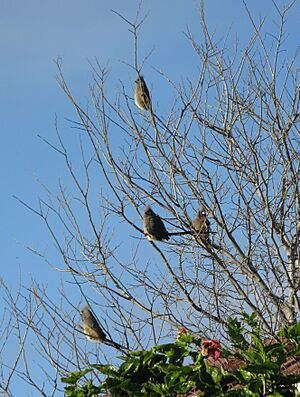White-backed mousebird facts for kids
Quick facts for kids White-backed mousebird |
|
|---|---|
 |
|
| The black-tipped bill is diagnostic among local species of mousebirds | |
| Conservation status | |
| Scientific classification | |
| Genus: |
Colius
|
| Species: |
colius
|
| Synonyms | |
|
Loxia colius Linnaeus, 1766 |
|
The white-backed mousebird (Colius colius) is a type of mousebird. It lives in western and central parts of southern Africa. You can find it in countries like Namibia and southern Botswana, stretching east to the Central Transvaal and the eastern Cape.
This bird likes dry, bushy places. It lives in areas with thorny bushes, fynbos scrub, and semi-deserts.
Contents
What Does the White-backed Mousebird Look Like?
This mousebird is about 34 cm (13.5 in) long. Its tail makes up about half of its total length! It weighs between 38–64 g (1.3–2.3 oz).
Its head, chest, and a cool crest on its head are grey. It has a white stripe on its back. This stripe is between two wide black stripes. Near its tail, there's a dark red band. You usually only see the white back stripe when the bird's wings are open, like when it's landing or when it's hot. Its belly is a light brown color.
The white-backed mousebird has a bluish-white beak with a black tip. Its legs and feet are red. You can tell it apart from the speckled mousebird by looking at its beak, legs, and the colors on its upper body.
What Do White-backed Mousebirds Eat?
White-backed mousebirds love to eat plants! They are called frugivores because they mostly eat fruits and berries. They also munch on leaves, seeds, and nectar.
Sometimes, they eat the buds of plants. This can make them unpopular with people who grow fruit or have gardens. Because of this, they are usually quite shy. If they see a human, they often sit very still in a tree or fly away quickly.
These birds also help spread seeds. When they eat berries from native plants, they help new plants grow by spreading the seeds. But they can also spread seeds from plants that are not native and can take over an area.
How Do White-backed Mousebirds Behave?
White-backed mousebirds are very social birds. They live in small groups, which are probably family members. They often feed together and even preen (clean their feathers) each other. At night, they roost (sleep) together in groups.
They perch in a funny way, almost like parrots. They often hang from their legs instead of just sitting on a branch. Sometimes, they even grip different branches with each leg!
White-backed Mousebird Reproduction
These birds usually stay in one area. They can have babies at any time of the year if the weather and food are good. Their nest is a large cup shape, and they hide it well in thick bushes.
Both parents feed the baby birds. Older young birds from previous families often help feed the new babies too.
What Sounds Do They Make?
The white-backed mousebird has a whistle-like call that sounds like zwee-wewit. They also make a buzzing or crackling sound. This sound might be used to warn others of danger or to stay in touch with their group.
Images for kids





